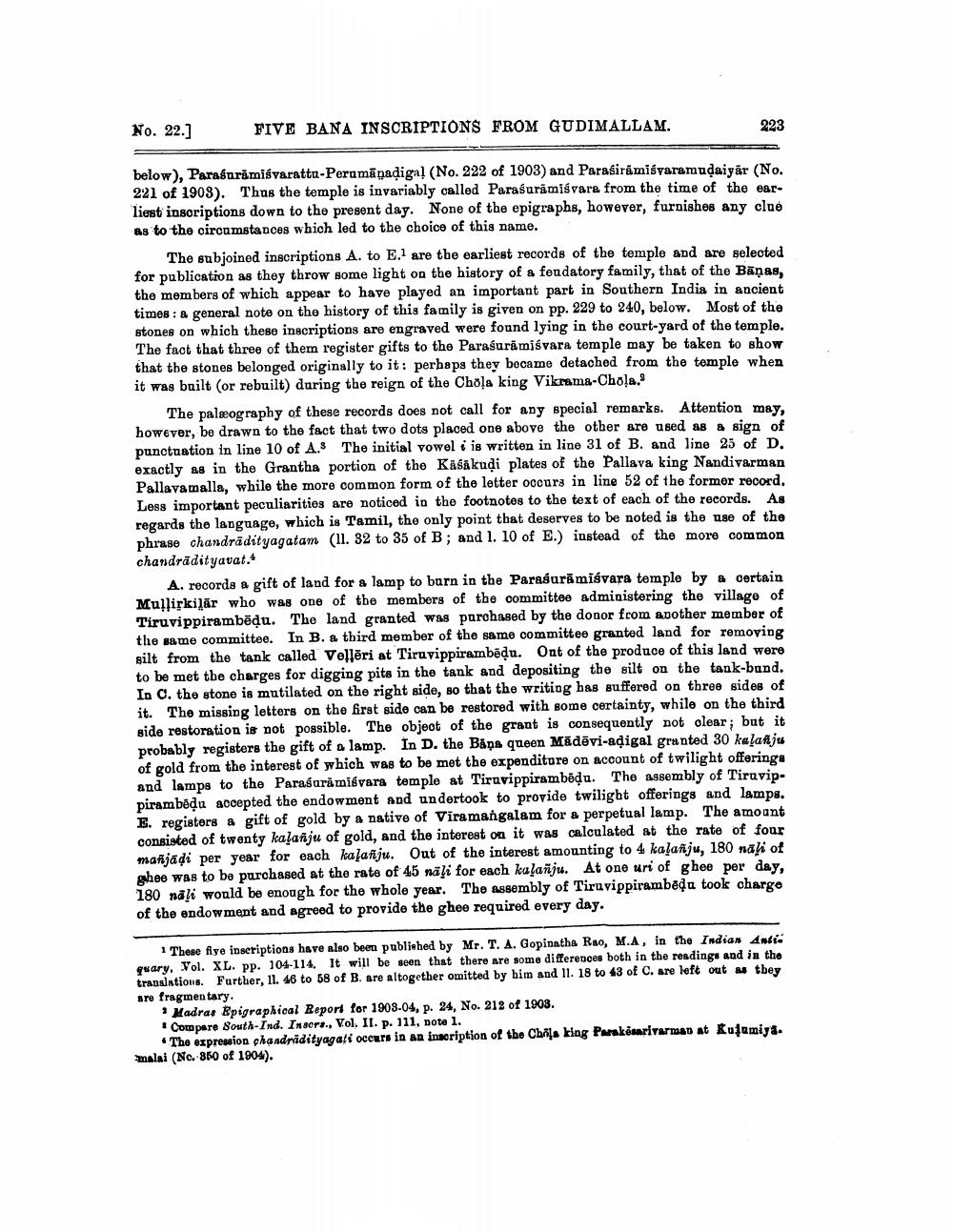________________
FIVE BANA INSCRIPTIONS FROM GUDIMALLAM.
No. 22.]
below), Parasuramisvarattu-Perumanaḍigal (No. 222 of 1903) and Parasiramisvaramuḍaiyar (No. 221 of 1908). Thus the temple is invariably called Parasuramisvara from the time of the earliest inscriptions down to the present day. None of the epigraphs, however, furnishes any clue as to the circumstances which led to the choice of this name.
223
The subjoined inscriptions A. to E.1 are the earliest records of the temple and are selected for publication as they throw some light on the history of a feudatory family, that of the Banas, the members of which appear to have played an important part in Southern India in ancient times: a general note on the history of this family is given on pp. 229 to 240, below. Most of the stones on which these inscriptions are engraved were found lying in the court-yard of the temple. The fact that three of them register gifts to the Parasuramiśvara temple may be taken to show that the stones belonged originally to it: perhaps they became detached from the temple when it was built (or rebuilt) during the reign of the Chola king Vikrama-Chola.
The paleography of these records does not call for any special remarks. Attention may, however, be drawn to the fact that two dots placed one above the other are used as a sign of punctuation in line 10 of A. The initial vowel i is written in line 31 of B. and line 25 of D. exactly as in the Grantha portion of the Käsäkuḍi plates of the Pallava king Nandivarman Pallavamalla, while the more common form of the letter occurs in line 52 of the former record. Less important peculiarities are noticed in the footnotes to the text of each of the records. As regards the language, which is Tamil, the only point that deserves to be noted is the use of the phrase chandradityagatam (11. 32 to 35 of B; and 1. 10 of E.) instead of the more common chandradityaval.
A. records a gift of land for a lamp to burn in the Parasuramisvara temple by a certain Mullirkilar who was one of the members of the committee administering the village of Tiruvippirambēdu. The land granted was purchased by the donor from another member of the same committee. In B. a third member of the same committee granted land for removing silt from the tank called Velleri at Tiruvippirambēdu. Ont of the produce of this land were to be met the charges for digging pits in the tank and depositing the silt on the tank-bund. In C. the stone is mutilated on the right side, so that the writing has suffered on three sides of it. The missing letters on the first side can be restored with some certainty, while on the third side restoration is not possible. The object of the grant is consequently not clear; but it probably registers the gift of a lamp. In D. the Bapa queen Mādēvi-adigal granted 30 kalanju of gold from the interest of which was to be met the expenditure on account of twilight offerings and lamps to the Parasuramisvara temple at Tiruvippirambēḍu. The assembly of Tiruvippirambēdu accepted the endowment and undertook to provide twilight offerings and lamps. E. registers a gift of gold by a native of Viramangalam for a perpetual lamp. The amount consisted of twenty kalañju of gold, and the interest on it was calculated at the rate of four mañjāḍi per year for each kalañju. Out of the interest amounting to 4 kalañju, 180 nali of ghee was to be purchased at the rate of 45 nali for each kalanju. At one uri of ghee per day, 180 nali would be enough for the whole year. The assembly of Tiruvippirambedu took charge of the endowment and agreed to provide the ghee required every day.
1 These five inscriptions have also been published by Mr. T. A. Gopinatha Rao, M.A, in the Indian Antiquary, Vol. XL. pp. 104-114. It will be seen that there are some differences both in the readings and in the translations. Further, 11. 46 to 58 of B. are altogether omitted by him and 11. 18 to 43 of C. are left out as they are fragmentary.
Madras Epigraphical Report for 1908-04, p. 24, No. 212 of 1908.
Compare South-Ind. Inscrs., Vol. II. p. 111, note 1.
The expression chandradityagati occurs in an inscription of the Chila king Parakesarivarman at Kujumiya. malai (Nc. 350 of 1904).




